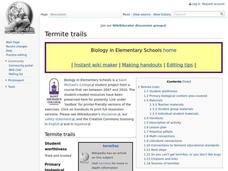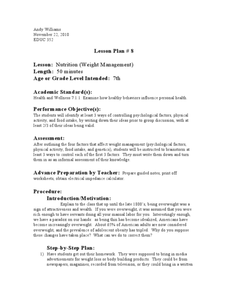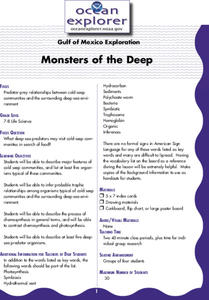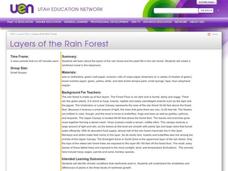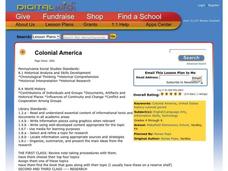Curated OER
Ecological Pyramids
Students apply the ecological pyramids of numbers and biomass with an activity using topographic maps. In this trophic level lesson, students work in groups using a topographic map to determine the number of organisms that can live in an...
Curated OER
Winter Survival
Students examine what animals need in order to survive. In this investigative lesson plan students play a "role" of an animal in winter.
Curated OER
Termite Trails
Students observe termite trail-following behavior. In this termite trails lesson, students draw a circle or other shape approximately eight inches across with a ball point pen. Teacher taps out termites into the circle and request that...
Curated OER
Spiders
Students read books and make art projects dealing with spiders. In this spiders lesson plan, students learn about the different characteristics of spiders through listening, answering questions, and making spiders.
Curated OER
How to Catch a Fish
Students conduct an experiment to demonstrate the effects of different fishing methods. In this commercial fishing lesson plan students create posters and public announcements to share their information.
Curated OER
Nutrition (Weight Management)
Seventh graders explore nutrition and the effect it has by participating in class discussions. In this diet and exercise lesson plan, 7th graders analyze print advertisements and discuss how unrealistic their expectations are and how...
Curated OER
A SALT WATER-Y WORLD
High schoolers observe a model of the distribution of the earth's water and compare the relative volumes and percentages of types of water on earth.
Curated OER
Monsters of the Deep
Students describe major features of cold seep communities, and list at least five organisms typical of these communities. They infer probable trophic relationships among organisms typical of cold-seep communities.
Curated OER
Wanted: Water!
Students determine what percentage of the Earth is water and how much water is needed by humans.
Curated OER
Layers of the Rainforest
Third graders identify, compare, and contrast the rainforests' climates. After reading Jane Yolen's Welcome to the Green House, they create a rainforest bulletin board.
Curated OER
"English Colonies"
Fifth graders create a tri- fold brochure around the topic of a colonial settlement that has been studied in the classroom for about 2 weeks prior to the workshop. They work with Publisher to create a brochure about a specific...
Curated OER
Wetland Adaptation
Fourth graders study the impact of the wetland environment on the migration of birds. They make a list of the important reasons on a large piece of paper to be posted in the classroom and point out the biggest wetland in the state (The...
Curated OER
What's Mongolia Really Like?
Learners look at rural Mongolian nomadic culture through the eyes of a Peace Corps Volunteer and examine the dynamics of a people in transition. They give one important reason for migration from a rural to an urban setting and explain...
Curated OER
Wacky Water Critters
Students visit a local creek or stream. They collect water samples from the creek and observe and sort the "water critters" they find in the sample, observing smaller organisms under a microscope if necessary. They identify each organism...
Curated OER
Total English Advanced : Imaginary Situations
In this modals of deduction practice worksheet, students read 3 imaginary situations and complete the 4 sentence starters that follow each one.
Curated OER
My Friend, The Volcano
Students describe the positive impacts of volcanic activity on marine ecosystems. In this volcano lesson students explore the process that causes volcanic activity along the Mariana and Kermadec Island Arcs.
Curated OER
Colonial America
Students discover the history of Colonial America by creating a class presentation. In this U.S. History lesson, students utilize the Internet to research one of 20 topics in which they will create a PowerPoint or other type of...
Curated OER
Where's the Point?
Students examine runoff for the causes, the impact, and the solution. In this investigative lesson students construct a three dimensional model of a watershed and provide information of contaminated runoff to their audience.
Curated OER
Shells
Sixth graders label diagrams of the 6 different classes of mollusks and explain the meaning of the labeled terms. They identify 8 common New Haven shells. They organize their own shell collection during this series of lessons.
Curated OER
Air Pressure
Students get a better understanding of air pressure and how it effects our daily lives.
Curated OER
guided reading lesson using BATS
Students answer questions, then after reading several bat books, students revisit the questions.
Curated OER
Mesoamerican Codex Books
Fifth graders use visual art as a form of communication as they create a codex book based on their knowledge of Mesoamericans.
Curated OER
What Bees Eat
Students consider the concept that plants and animals are dependent on one another and role-play the interaction between bees and flowers. They identify crops that are dependent on pollination by bees.
Curated OER
See How They Grow: Plants And Their Parts
Students discuss what plants require in order to grow, identify plant parts and their functions and discuss a video about plants. They conduct a controlled experiment with bean seeds and then record and observe the bean plants.




